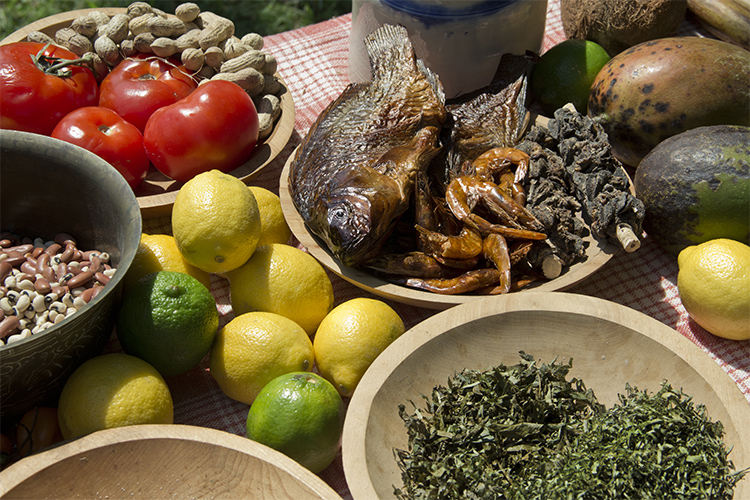Kwanzaa originates from the Swahili phrase “matunda ya kwanza,” signifying the “first fruits of the harvest.” Emerging in the late ’60s, it celebrated cultural affirmation inspired by sub-Saharan African harvest festivals. As it gained prominence in the African-American community, the focus shifted from African foods to those more familiar within the African diaspora. Examples of Kwanzaa’s delicious foods include: Catfish, collards, and macaroni and cheese became staples alongside jerk chicken, gumbo, accras (Caribbean fritters), and feijoada, reflecting the diverse cuisines across the Atlantic rim influenced by the African diaspora.
Kwanzaa’s Delicious Foods

Kwanzaa’s Delicious Foods are quite flexible—They encompass dishes prepared specifically for the occasion. There aren’t rigid guidelines; however, the spread typically blends elements from sub-Saharan Africa (both East and West), soul food, and coastal dishes from the Atlantic rim, all bearing evident connections to African or African-American origins.
The customary table often features symbolic foods: mazao, a representation of the harvest’s abundance. It usually includes foods from the African diaspora like okra, yams, squash, sweet potatoes, and bananas). Alongside these are muhindi, ears of corn symbolizing each child still residing at home. These are accompanied by essential items like the kikombe cha umoja (a communal chalice), zawadi (gifts), and kinara (a seven-branched candle holder for the red, black, and green candles lit each evening).
The Menu of Kwanzaa’s Delicious Foods
Family traditions heavily influence the diverse Kwanzaa menu, and soul food spanning from the whole African continent. A central feature often revolves around one-pot stews or braises drawing from varied traditions:
Examples of Kwanzaa’s Feast Foods

Whether you’re joining your community for a festive gathering or having an intimate family celebration at home, these recipes ensure you serve nothing but the finest at your table.
- Ghanaian groundnut stew
- West Indian or South African curry dishes
- Philadelphia pepper pot stew
- Jambalaya,
- Nigerian jollof rice,
- Senegalese thieboudienne.
Starches add variety, including rice, couscous, candied yams, buttermilk biscuits, spoonbread, plantains, fritters, hoppin’ John, and injera. Above all, the essence lies in communal sharing, for Kwanzaa fundamentally celebrates community.
The Best Kwanzaa Recipes
During Kwanzaa, families cherish a diverse range of dishes tied to their heritage. For a dose of inspiration, check out these recipes. The dishes hold stories steeped in tradition, like akara—a fritter made from black-eyed peas. These peas, a symbol of resilience and blessings, hold historical significance for Black American cooks post-Civil War.
Main Meal: Black-Eyed Peas with Bacon
Best Black-Eyed Peas
Spicy Black-Eyed Peas
Black-Eyed Pea Salad
Sides: Sweet Potatoes Galore
Mashed Sweet Potatoes
Sweet Potatoes and Apples
Sweet Potato Fries
Mac and Cheese Extravaganza
Make Mac and Cheese
Stovetop Mac and Cheese
Fried Mac and Cheese
Mac and Cheese 2 Ways
Veggie Favorite: Okra Delights as Kwanzaa’s Delicious Foods
Veggie Favorite: Okra
Stewed Okra and Tomatoes
Sunny’s Fried Okra
Turkey and Okra Dinner
Here is a full recipe of one of the most loved Kwanzaa’s Delicious Foods. Try making it during this upcoming season and enjoy
Crispy Àkàrà with Savory Smoky Sesame Sauce : Kwanzaa’s Delicious Foods
Àkàrà, a bean cake or fritter from the Yoruba and Igbo languages, is a popular street snack in West Africa and a key part of Atlantic Creole cooking across the New World, including the American South. Made from black-eyed peas, it became well-known among Black American cooks after the Civil War, symbolizing resilience and good luck. Our family tradition includes eating black-eyed peas at New Year’s for luck. This sesame sauce is easy to make, versatile, and tastes delicious—akin to a vegan chipotle mayo. It needs just a few basic pantry ingredients and pairs nicely with Akara. You can also enjoy akara with tomato or tomatillo salsa.
Ingredients:
- 1 lb dried black-eyed peas, sorted and cleaned
- 1 1/4 cups minced shallots
- 1 cup diced mixed bell peppers (red, yellow, and green)
- 1/2 cup finely chopped green onion (dark green parts)
- 2 tbsp minced garlic
- 1 tsp kosher salt
- Freshly ground black pepper
- 1 1/2 cups rice flour
- High-heat oil (like refined coconut oil or non-hydrogenated organic shortening) for frying
Simple Savory Smoky Sesame Sauce:
Ingredients:
- 1/2 cup organic tahini sauce (roasted sesame paste)
- 1 tbsp smoked paprika
- 1 1/2 tsp blue agave
- 1 tsp dried minced onion flakes
- 1 tsp granulated garlic or garlic powder
- 1/2 tsp kosher salt
- Zest and juice of 1/2 lemon
- 2 tbsp unseasoned rice vinegar
Instructions on how to make Crispy Àkàrà with Savory Smoky Sesame Sauce
- Rinse the black-eyed peas and soak in water for 6 to 8 hours. Drain them and discard the soaking water.
- Remove the pea skins: Either rub them between your palms or pulse them in a food processor with some water, then strain and remove the skins.
- Put the peeled peas in a food processor, add 1/2 cup water, and process into a thick paste.
- Mix in shallots, bell peppers, green onion, garlic, salt, and pepper until smooth. Add rice flour and stir into a thick batter.
- Heat coconut oil or shortening in a skillet to 375°F. Carefully place tablespoon-sized scoops of the mixture into the hot oil and deep-fry until golden brown (2-3 minutes per side). Drain on paper towels.
- Serve with Savory Smoky Sesame Sauce.
Savory Smoky Sesame Sauce: Kwanzaa’s Delicious Foods
- Combine tahini, paprika, agave, onion flakes, garlic, salt, lemon zest, and juice in a measuring cup.
- Stir in rice vinegar. The mixture may thicken, so add 1/4 cup warm water and stir until it reaches a creamy consistency.
- Transfer to a serving bowl or individual dishes for dipping. Enjoy!
TAKE NOTE
The peas or beans can soak for up to 24 hours. You can leave them at room temperature for some time and then refrigerate them overnight. The longer they soak, the easier it will be to remove the outer skins. If some specks or bits of the pea skins remain, it’s okay—remember, “perfection is the enemy of the good.”



